Korean BBQ at Home: A Guide
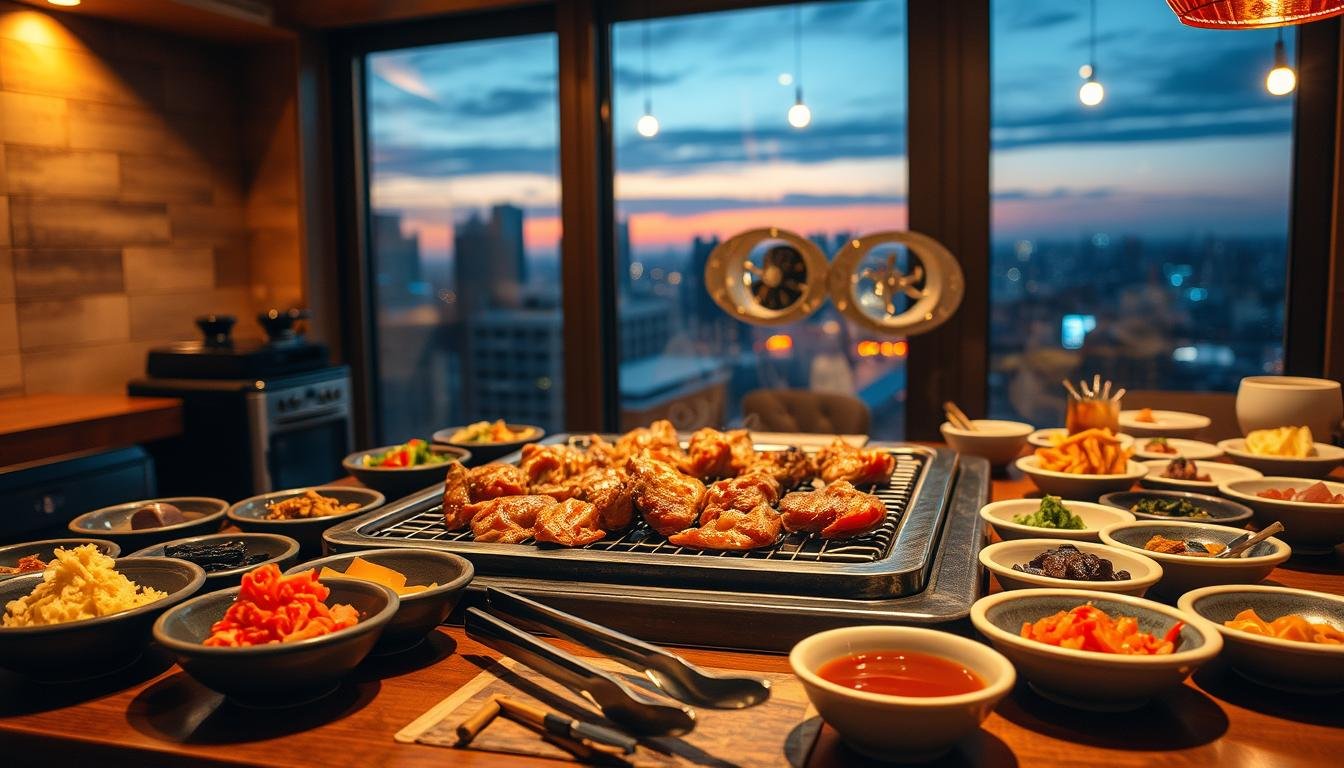
Ever thought of making a simple get-together into a memorable food adventure? Korean BBQ is here to make it happen! It’s more than just grilling; it’s a fun way to share meals with loved ones. You’ll learn how to make your own Korean BBQ at home, with tasty meats, yummy marinades, and vibrant side dishes.
Understanding Korean BBQ: What Makes It Unique?
Korean BBQ is a big deal in many places. It’s loved by many, not just Koreans. It’s all about eating together and having fun.
The Cultural Significance of Korean BBQ
Korean BBQ is a big part of social events. It makes meals fun, with everyone choosing and grilling their own meat. This way, everyone gets to enjoy and share the food together.
Key Ingredients in Korean BBQ
Beef and pork are the stars of Korean BBQ. Galbi, or short ribs, are grilled fast to get that perfect char. The meat is marinated in special sauces that make it taste amazing.
There are also special sauces and lettuce leaves for wrapping the meat. Side dishes, or banchan, add variety and balance out the flavors.
Traditional Cooking Methods
Grilling over charcoal is key to Korean BBQ’s taste. It gives the meat a smoky flavor. Bulgogi is often cooked in a skillet for ease.
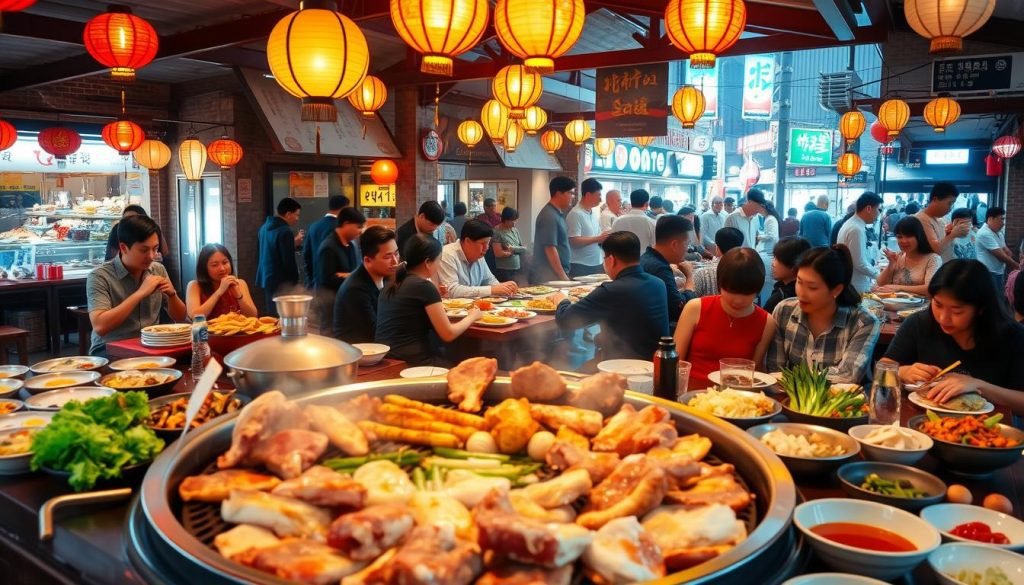
| Key Elements | Description |
|---|---|
| Cultural Significance | Transforms meals into communal experiences through shared grilling. |
| Unique Ingredients | Emphasizes quality cuts of beef and pork with distinct marinades. |
| Grilling Techniques | Utilizes charcoal for high heat; skillets for specific dishes. |
| Accompaniments | Includes ssamjang and a variety of banchan to complement meats. |
Essential Equipment for Your Korean BBQ Setup
Creating the perfect Korean BBQ at home needs the right tools. A good setup means tasty grilled food and fun times with family and friends. Let’s look at what you need for your Korean BBQ kitchen.
Choosing the Right Grill
Your BBQ grill choice affects taste and ease. Here are some top picks:
- Tabletop Gas Grills: Portable and simple, these use butane gas canisters, saving money.
- Charcoal Grills: For a smoky taste, charcoal grills are the way to go, but they’re harder to start.
- Electric Grills: Great for indoor use, electric grills are easy to use and control heat well.
Must-Have Utensils and Tools
These grilling tools will make your Korean BBQ better:
- Tongs: Key for flipping meat safely and getting a nice char.
- Scissors: Handy for cutting meat into small pieces.
- Serving Plates: Keep meat organized and look nice on the table.
- Small Bowls: Great for sauces and marinades, making grilling easier.
Setting Up Your Cooking Area
Make your cooking area efficient for easy grilling. Focus on these tips:
- Put your BBQ grill in the middle of the table for fun.
- Use fans or open windows to keep smoke away.
- Keep your grilling tools close so you can grab what you need fast.

With the right grill, tools, and setup, you’re ready for a tasty Korean BBQ at home. Enjoy grilling!
Popular Types of Meats for Korean BBQ
Korean BBQ meats are full of flavors and textures. Choosing the right meat is key for a true taste. Knowing the popular meats makes your BBQ better and more fun.
Showcase Different Cuts of Beef
Beef has special cuts for great taste and texture. Short ribs, or kalbi, are top picks for Korean BBQ. They come from the 6th, 7th, or 8th rib and are juicy and tasty.
Beef brisket, or chadolbaegi, is also loved. It needs good marbling for grilling. The outside skirt steak, or ahnchangsal, is tender and tasty, like ribeye and filet mignon.
Delicious Pork Options
Pork belly, or samgyeopsal, is a favorite for its fat and flavor. Pork jowl, or hangjeongsal, is gaining fans. It’s less fatty than belly but still tasty.
Market research shows pork belly is a hit, making up 28% of BBQ choices. Neck meat, or moksal, is also popular, at 22%. These cuts offer rich flavors and appeal to many.
Flavorful Chicken Varieties
Chicken bulgogi is great for those who like chicken. Chicken thighs, or dalg heobeogji, are juicy and tasty. They come from places that specialize in chicken.
Chicken bulgogi is not as common as beef or pork. But it adds a special touch to the grill, pleasing many.

| Type of Meat | Popular Cuts | Key Characteristics |
|---|---|---|
| Beef | Short ribs (Kalbi), Brisket (Chadolbaegi), Outside Skirt (Ahnchangsal) | High fat content, rich flavor, ideal for grilling |
| Pork | Pork Belly (Samgyeopsal), Pork Jowl (Hangjeongsal) | Succulent texture, versatile in recipes |
| Chicken | Chicken Thigh (Dalg Heobeogji), Chicken Bulgogi | Juicy and flavorful, best from specialty sources |
Marinades and Sauces to Elevate Your BBQ
Flavorful marinades and sauces make Korean BBQ better. Try galbi marinade for sweetness or gochujang sauce for heat. These recipes add flavor to your grilling.
Classic Galbi Marinade Recipe
The galbi marinade is sweet and savory. It makes about 7 fluid ounces for 6 servings. It takes 10 minutes to make and 15 minutes total.
Let the meat marinate for at least 30 minutes. This lets the flavors soak in.
- ⅓ cup plus 1 tablespoon soy sauce
- 1½ tablespoons rice vinegar
- 2 teaspoons freshly grated ginger
- 3 cloves minced garlic
- 1 tablespoon chili garlic sauce
- 1 teaspoon red pepper flakes (adjust to taste)
- 1 tablespoon corn starch for thickening
- Maple syrup or light brown sugar as primary sweetener
The marinade has about 65 calories per serving. Store it in the fridge for up to 1 week or freeze for up to 1 month.
Spicy Gochujang Sauce Essentials
This sauce uses gochujang for a unique flavor. Mix it with soy sauce, honey, garlic, and ginger. It’s great for dipping ribs and other meats. You can adjust the spice level to your liking.
Other Popular Dipping Sauces
There are many dipping sauces for Korean BBQ. Here are a few:
- Ssamjang: A mix of fermented soybean paste and gochujang, perfect for wrapping meats in lettuce.
- Tangy Sesame Ginger Marinade: A mix of sesame oil, soy sauce, and ginger for a balanced taste.
- Sweet Honey Glaze: A quick sauce that’s good with all proteins.
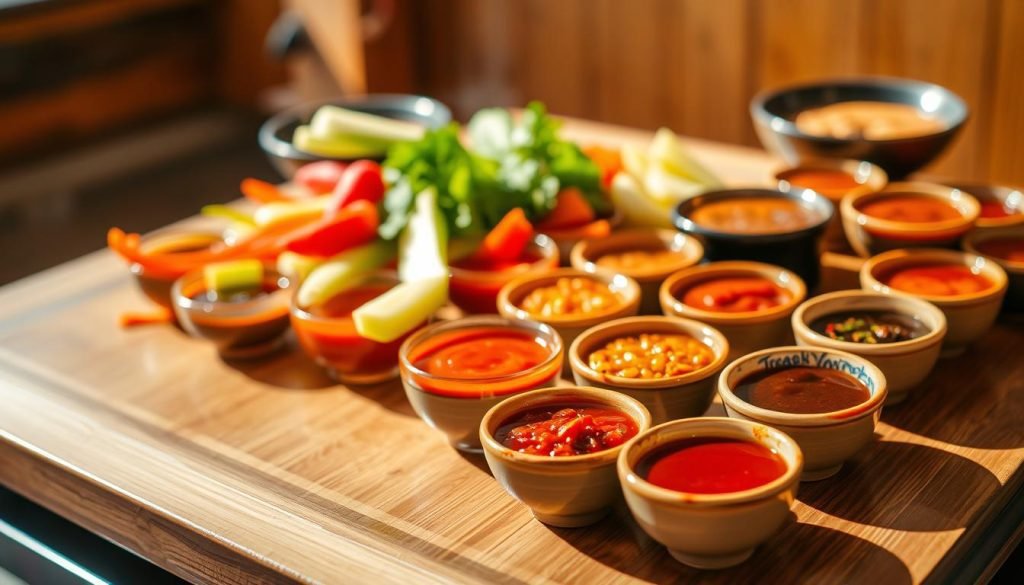
These sauces and marinades add flavor to your dishes. They’re a great way to enjoy Korean food at home. Try them out and find your favorites!
Preparing Your Ingredients: A Step-by-Step
Success in Korean BBQ starts with good ingredient prep. From slicing to marinating, each step is key. Follow this guide for a great Korean BBQ experience.
Slicing Meat and Vegetables
Even cuts are important for cooking. Use ¼ inch thick slices for proteins like pork belly and bulgogi. For veggies, try:
- Bell peppers
- Onions
- Sweet potatoes
- Garlic cloves
This makes cooking quick and looks great too.
Marinating the Meat Properly
Marinating boosts flavor. Start marinating at least 30 minutes before grilling. Use these ingredients:
| Ingredient | Purpose |
|---|---|
| Soy Sauce | Base flavor |
| Sugar | Sweetness |
| Garlic | Depth of flavor |
| Sesame Oil | Richness |
Bulgogi needs a sweet and savory marinade. Chicken might need special care for tenderness.
Preparing Side Dishes
Korean BBQ meals include many side dishes, or banchan. Try these:
- Kimchi
- Cucumber Salad
- Spinach Side Dish
- Potato Salad
These add flavor and color. Dipping sauces like ssamjang make it even better. Good prep means a great BBQ.
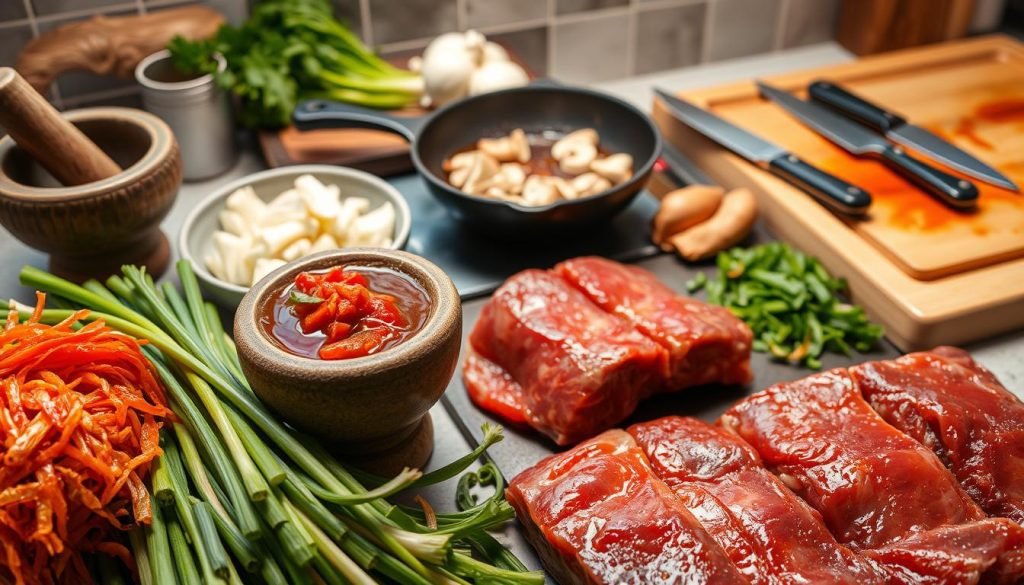
Side Dishes (Banchan) to Serve with Korean BBQ
In a traditional Korean BBQ meal, banchan is key. You’ll find 8 to 10 different banchan items. They add flavors and textures to your meal.
These Korean side dishes go well with grilled meats. They also make your meal balanced.
Must-Have Banchan Options
- Kimchi (fermented cabbage) – A staple in almost every meal
- Pickled radish (Ssam-mu) – Refreshing and customizable
- Seasoned soybean sprouts
- Roasted seaweed sheets – Gaining popularity for their ease of preparation
- Oi Muchim (spicy cucumber salad) – Versatile and flavorful
- Gamja Jorim (braised potatoes) – Comfort food for many
- Hobak Bokkeum (Korean zucchini stir fry) – Quick and delicious
- Sanjeok (skewered and grilled vegetables) – Often enjoyed during festive celebrations
How to Prepare Common Banchan
Preparing banchan can be done ahead of time. This saves you time during your BBQ. Here are a few tips:
- Kimchi: Ferment napa cabbage in a spicy mixture of gochugaru, garlic, and fish sauce for a few days to develop flavor.
- Oi Muchim: Toss sliced cucumbers with gochugaru and vinegar for a quick spicy salad.
- Hobak Bokkeum: Stir-fry zucchini with a pinch of salt and garlic in less than 10 minutes.
- Pickled radish: Quick-pickle radish slices in vinegar and sugar for a refreshing crunch.
The Role of Banchan in Your Meal
Banchan is more than just a side. It’s a key part of your meal. It brings different tastes to each bite.
In Korean dining, you match flavors. For example, spicy dishes with sweet potatoes. This mix of Korean side dishes makes your meal look and taste great.
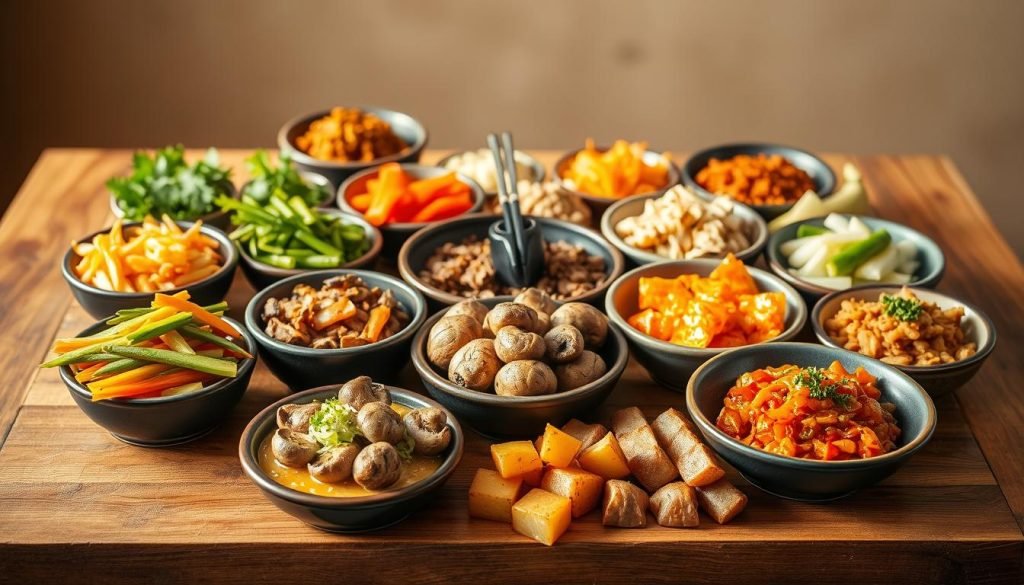
| Banchan | Main Ingredients | Preparation Time |
|---|---|---|
| Kimchi | Napa cabbage, gochugaru | 3 days (fermentation) |
| Oi Muchim | Cucumber, vinegar, gochugaru | 10 minutes |
| Hobak Bokkeum | Zucchini, garlic | 10 minutes |
| Gamja Jorim | Potatoes, soy sauce | 30 minutes |
| Sanjeok | Vegetables, skewers | 20 minutes |
With each banchan offering unique flavors and textures, you create a delightful experience. It’s something that family and friends will enjoy. These dishes make your Korean BBQ even better.
Hosting a Korean BBQ: Tips for Success
Hosting a Korean BBQ is a great way to bond with friends and family. It’s fun from the start, with everyone excited to come. Make sure to have lots of meats, sides, and sauces for everyone to enjoy.
Inviting Your Friends and Family
Make your invites fun by talking about the interactive BBQ. Add personal touches to make it exciting. Mention the special meats like wagyu beef and kurobuta pork. Also, ask guests to bring their favorite sides.
Planning Your Menu
Your menu should have lots of flavors and textures. Here are some ideas:
- Meats: Try bulgogi, galbi, and samgyeopsal.
- Marinades: Offer soy-garlic, gochujang, and bulgogi flavors.
- Banchan: Serve kimchi, pickled radish, and Korean pancakes.
- Drinks: Serve soju, makgeolli, or barley tea for a drink.
Creating a Fun Atmosphere
A lively atmosphere makes the meal more fun. Here are some tips:
- Arrange seats for easy talking.
- Play upbeat music to keep everyone happy.
- Let everyone help with grilling.
- Have guests pour drinks for each other.
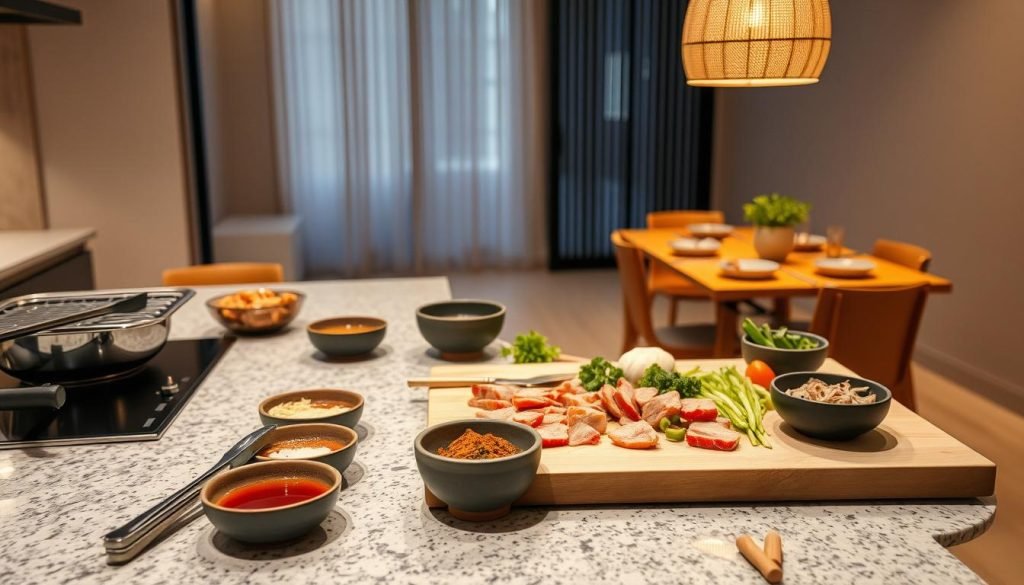
Cooking Techniques for Perfectly Grilled Meat
Mastering grilling techniques is key for great Korean BBQ. Knowing when to use direct and indirect grilling makes meat taste better and feel softer.
Direct Grilling vs. Indirect Grilling
Direct grilling means meat is right over the heat. It’s best for thick cuts like bulgogi or galbi. It makes them brown and sweet.
Indirect grilling is gentler. It’s for thin meats like pork belly or seafood. It keeps them juicy and soft.
Tips for Achieving the Perfect Char
Getting a good char takes patience. Cook for two minutes on one side before flipping. This makes the meat tender inside and crispy outside.
High heat is important for a nice char. Make sure your grill is hot before cooking. Marinades help too, making meat taste better and feel softer.
Timing Your Cooking for Best Results
Timing is everything in Korean BBQ. Grill tough items first, then add quicker ones. This way, everything cooks well and tastes great.
Each meat cooks differently. Use a chart to know how long to grill each one. This makes cooking easier and more fun.
| Meat Type | Recommended Cooking Time (minutes) | Grilling Technique |
|---|---|---|
| Ribeye | 3-4 | Direct Grilling |
| Pork Belly | 2-3 | Indirect Grilling |
| Short Ribs (Galbi) | 5-6 | Direct Grilling |
| Seafood (Shrimp, Calamari) | 2-3 | Indirect Grilling |
| Chicken Thighs | 6-8 | Indirect Grilling |

Enjoying Your Korean BBQ Meal: Etiquette and Traditions
Korean BBQ is more than food; it’s a tradition that brings people together. Knowing how to act at the table makes the experience better. It’s all about sharing and enjoying the meal with others.
Sharing and Serving Practices
Sharing is key in Korean BBQ. You’ll find many side dishes, or banchan, to share. It’s okay to use your hands for some foods, but not all.
Don’t leave food in shared dishes. It’s seen as rude. Keeping things clean shows respect for everyone at the table.
Traditional Korean Drinking Customs
Drinking is important in Korean culture. Always offer drinks to others before you take one. South Koreans love to drink soju, often in big shots.
Saying “geon-bae” when you toast is a nice touch. It makes the meal feel more like a celebration with friends and family.
Cleaning Up After the Feast
Cleaning up is part of the meal. In Korea, it shows respect for where you eat. Even if servers do it in restaurants, at home, everyone helps.
This includes changing the grill and throwing away leftovers. It’s a way to show you appreciate the meal and the company.
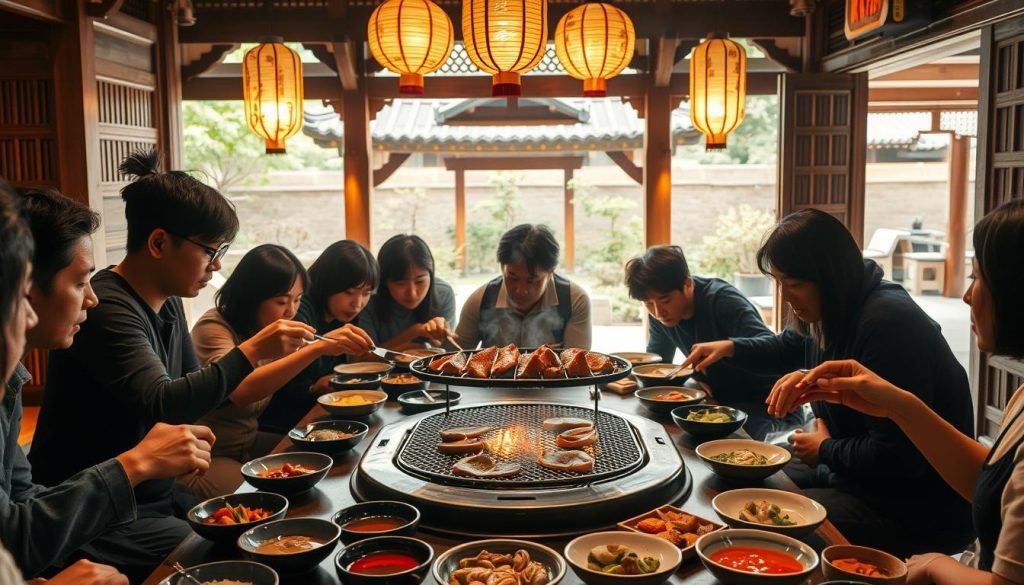
| Aspect | Importance |
|---|---|
| Shared Banchan | Essential for intimacy; 70% of diners consider sharing vital. |
| Eating Etiquette | Most dishes typically not eaten by hand; certain exceptions apply. |
| Drinking Customs | Encourages social bonding; polite to serve others first. |
| Post-Dinner Cleanup | Reflects respect for meal and dining companions. |
Exploring Variations of Korean BBQ
Korean BBQ has many styles and flavors from different parts of Korea. Bulgogi, a tasty beef dish, was introduced in the mid-20th century. Samgyeopsal, or grilled pork belly, is another favorite. Each region has its own special way of making these dishes.
This makes Korean BBQ more than just food. It’s a journey through history and culture. You’ll find many side dishes, or banchan, to enjoy with your meal.
Regional Styles of Korean BBQ
Every region in Korea has its own BBQ style. Jeju Island is known for its black pork, grilled to perfection. The north loves gochujang, a spicy sauce made from fermented ingredients.
These differences make Korean BBQ exciting. You can try many flavors and cooking methods. It’s a chance to explore new tastes and traditions.
Vegan and Vegetarian Alternatives
Vegetarians can enjoy Korean BBQ too. Use vegetables, tofu, and plant-based meats to make tasty dishes. Try marinating grilled mushrooms or zucchini in soy and sesame oil.
Make spicy gochujang dipping sauces for vegetable skewers. These options are great for BBQ nights. They add variety and make everyone happy.
Fusion Ideas for Your BBQ Night
Try mixing Korean BBQ with other cuisines for fun. Korean tacos with bulgogi and kimchi are a hit. Or, mix Italian pasta with Korean flavors for a unique dish.
These creative recipes will wow your guests. They bring bold flavors and cultural twists to your BBQ night. It’s a great way to make your event memorable and fun.